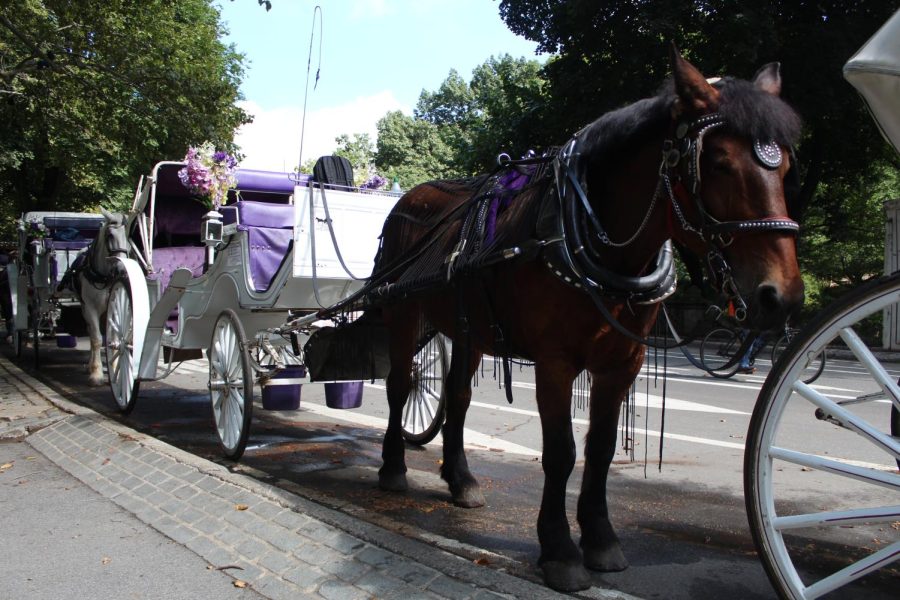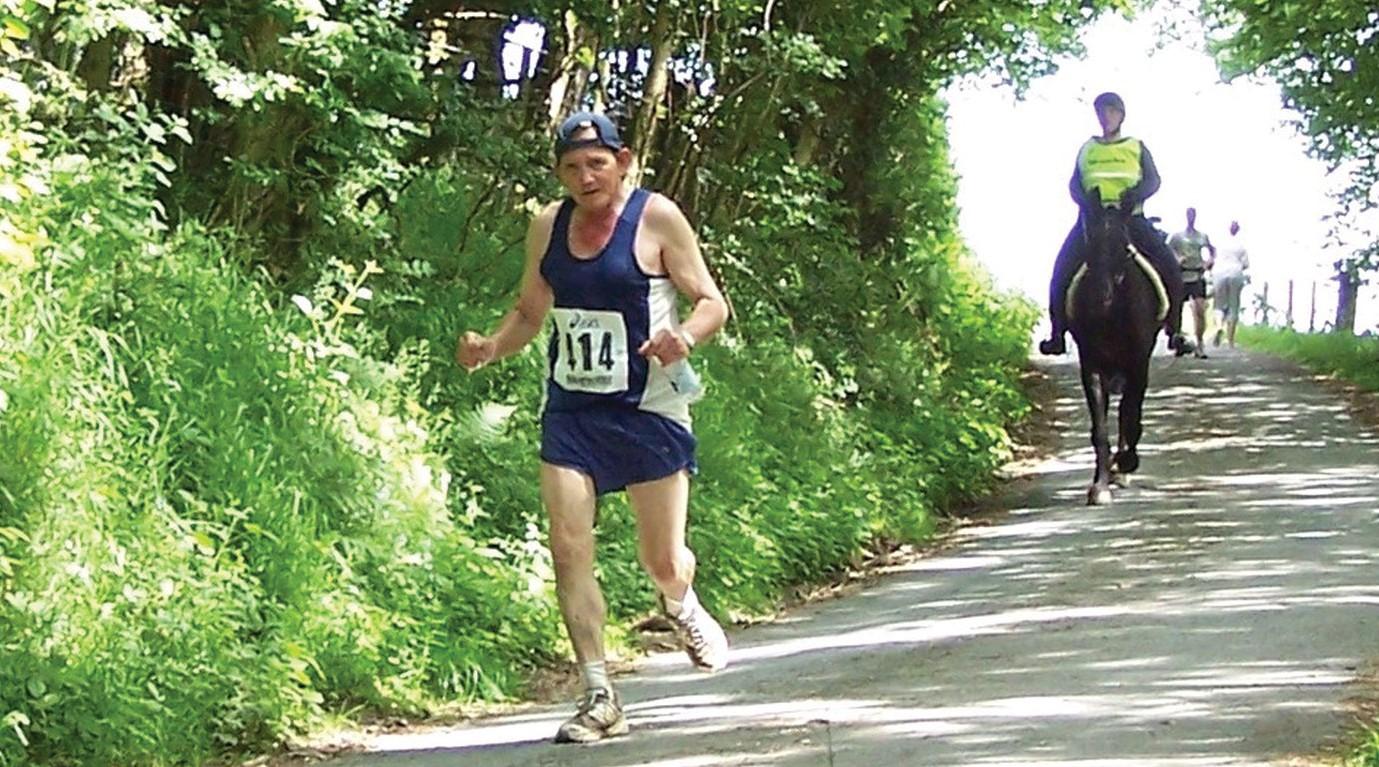The Fight to Ban Carriage Horses in NYC
Activists argue that the horses on New York City’s streets are suffering and that the practice should be replaced
Carriage horses withstand challenging conditions to take riders around New York City.
September 14, 2022
Ryder, a carriage horse in New York City, collapsed in Hell’s Kitchen on Aug. 10, 2022. Veterinarians speculate that Ryder is around 27 years old; the average age for a carriage horse ranges from 13-14, making him exceptionally old for his occupation. Ryder’s collapse occurred after a 7 and a half hour shift during a New York heatwave, where temperatures reached 90 degrees. The incident was unfortunately not shocking, as Ryder was later found to be malnourished, dehydrated and suffering from Equine Protozoal Myeloencephalitis (EPM), a disorder that attacks the central nervous system.
Ryder’s collapse sparked outrage from animal rights organizations around the globe.
“There’s no question that using horses to pull carriages through very busy and loud New York City streets is unsafe and an undeniable strain on the horses’ quality of life,” Maureen Linan from the American Society for the Prevention of Cruelty to Animals (ASPCA) said to the Observer.
“This latest tragic incident demonstrates that the most humane, responsible and sensible action is for New York to eliminate horse carriages from its streets.”
Criticism even reached celebrity interest. Bella Hadid expressed that she feels “It’s barbaric to force horses like Ryder to pull heavy carriages in extreme heat in the busiest part of the busiest city in America without a place to break or eat.” Hadid also shared her support for New York City Council Member Robert Holden, who is sponsoring Int. 573-2022, a bill to ban horse carriages and replace them with electrical ones.
If passed, the electric carriages would resemble a motor car from the early 1900s and would run at a speed of 3 miles per hour. Carriage horses, for reference, trot at a pace of 8 to 10 miles per hour. The electric carriages would be powered by lithium-ion batteries and run in all weather conditions, regardless of rain or snow. Built to invoke America’s Golden Age, the cars would be styled with gold rims and a “parasol” convertible top.
The guarantees of the new bill, however, appear unfavorable to carriage horse drivers with many believing the electric cars could never attain the attraction held by horses. Carriage horses embody the evolution of transportation and are a quintessential New York City experience for many tourists. Some feel without their presence, a definitive chapter of history would be lost. The question is: Are we willing to exploit an animal’s well-being to reenact the past?
On Aug. 11, New Yorkers protested outside City Hall in support of banning carriage horses. From activists to everyday citizens, protestors expressed their resentment towards an industry that exploits animal labor. Tony Ultano, a spokesperson for carriage horse drivers, responded: “The veterinarian who examined Ryder believed he has EPM, a neurological disease caused by possum droppings. This is another example of why people shouldn’t rush to judgment about our horses or the blue-collar men and women who choose to work with them and care for them.”
However, the fact that these horses are in contact with possum droppings further demonstrates the inhumane living conditions they face. EPM is developed through indigestion, which means Ryder was likely consuming rancid food by the presence of possum feces. Ultano also failed to mention that Ryder was malnourished and over the legal age requirement to pull a carriage. At his advanced age, EPM wasn’t the sole factor in his collapse.
The dwindling promise of stables and water troughs in Central Park sticks a loose Band-Aid on a harmful practice that ultimately must be banned.
In further support of carriage horse drivers, the Transport Workers Union proposed a re-evaluation of the carriage horse industry on Sept. 1. The union plans to relocate the horses to a building in Central Park and appoint a full-time veterinarian to monitor their health. Water troughs would additionally be built across the park to prevent dehydration, which was a major factor in Ryder’s collapse. Released a month after Ryder’s accident, their statement has been met with public scrutiny due to its prolonged response time.
However many revisions are promised, the carriage horse business is an unsustainable practice. Horses aren’t meant to withstand the commotion of New York City, as they’re regarded as generally timid creatures. The city is a destructive environment for an animal that relies on fields to graze, not sidewalks to trot. The dwindling promise of stables and water troughs in Central Park sticks a loose Band-Aid on a harmful practice that ultimately must be banned.
By urging friends and family to boycott horse-driven carriages and advocating for Holden’s bill to replace horse carriages with electric ones, we can end the animal neglect and abuse that is so prevalent in our city. Ryder’s incident may have been a rare case, but it’s indicative animal abuse in the industry.
It is up to us to stand up to the carriage horse industry and end this harmful practice once and for all.














Elizabeth Forel • Sep 20, 2022 at 5:33 pm
this is a letter I had published in The Chief recently. It explains more about this issue:
https://thechiefleader.com/stories/horse-sense,46789?fbclid=IwAR2GOUegTL2gN4reXDi6bf4LTc19E26gp7hINB5yOjcHJ0jvLxobWfSiwZo
Elizabeth Forel • Sep 20, 2022 at 5:30 pm
While I appreciate the sentiment, your facts are not correct: – and I strongly suggest that you verify (with the right people) what you think is true. The new proposed vehicle in Central Park is a duplicate electric carriage – NOT a car. And it is not meant to look like an old fashioned vehicle. That was a proposal from 2008-9 and went nowhere. Look at our website compassionatetourism.org.
Also – you say the union is “planning” stables in Central Park. They can “plan” all they want but it is something that will not happen unless the corruption is deeper than I think. Google park land alienation and you will see what I mean. It would end up on the courts for years and is simply a diversion. This was something that deBlasio proposed in 2015. – without doing any investigation. Good gov. groups threatened to sue. Now the Union thinks they can pull the wool over the eyes of – yes – politicians – who do not know better.
Caitlin Gamble • Sep 15, 2022 at 10:56 pm
This is so well-written. Thank you!!